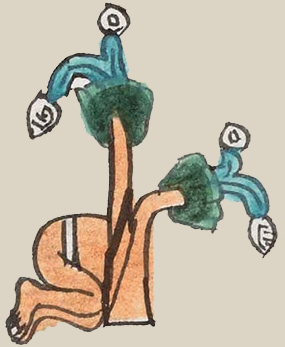Ahuatzitzinco (Mdz40r)
This compound sign for the place name Ahuatzitzinco has three principal elements: the oak tree (ahuatl) is the focus, with the turquoise-painted water (atl) flowing from the two-tone green foliage at the ends of the two branches and providing the phonetic start to the tree name. The water is painted in a standard way, with lines to show currents and shells and droplets (or beads, such as jadeite beads) splashing off the streams. Without the water, this tree looks much like a simple cuahuitl. Merging with the tree, on its left, is the lower half of a male body in profile (which would be facing to our right), referring to buttocks (tzintli), a phonetic indicator for the locative suffix -tzinco. The -tzin- is thus visual but the -co is not.
Stephanie Wood
The water provides a phonetic indicator that this tree name starts with "a." A literal reading of the place name might translate something like "At the Little Oaks." But Frances Karttunen proposes that -tzinco refers to a spin-off community. Since the original town was Ahuatzinco, the -tzinco has a reduplication, -tzitzinco. The locative -tzinco is what Gordon Whittaker calls a "secondary logogram." Sometimes, I suspect the diagonal black lines (tlilcuahuitl) are a phonetic indicator that the tree is a cuahuitl, but this is an exception, because it is an oak tree (ahuatl or āhuatl, with the diacritics).
Stephanie Wood
ahuaçiçinco. puo
Ahuatzitzinco, pueblo
Stephanie Wood
c. 1541, or by 1553 at the latest
Stephanie Wood
oaks, oak trees, ahuatl, bodies, bottoms, buttocks, rear ends, loincloths, water, little, lower, robles, encinos, nombres de lugares

a(tl), water, https://nahuatl.wired-humanities.org/content/atl
ahua(tl), oak tree, https://nahuatl.wired-humanities.org/content/ahuatl
tzin(tli), buttocks), https://nahuatl.wired-humanities.org/content/tzintli
-tzinco (locative suffix), lower, little, or new [town], https://nahuatl.wired-humanities.org/content/tzinco
https://nahuatl.wired-humanities.org/content/tzinco
-co (locative suffix), at, https://nahuatl.wired-humanities.org/content/co
cuahui(tl), tree(s), https://nahuatl.wired-humanities.org/content/cuahuitl-1
tlilcuahui(tl), black stripe(s), https://nahuatl.wired-humanities.org/content/tlilcuahuitl
"New Ahuatzinco" -- this is based on the interpretation of -tzinco as a locative suffix that refers to a spin-off community. [Frances Karttunen, unpublished manuscript, used here with her permission.]
"On the Very Small Oak Trees" (Berdan and Anawalt, 1992, vol. 1, p. 170)
"Nuevo Acatzinco"
Stephanie Wood
Codex Mendoza, folio 40 recto, https://digital.bodleian.ox.ac.uk/objects/2fea788e-2aa2-4f08-b6d9-648c00..., image 90 of 188.
The Bodleian Libraries, University of Oxford, hold the original manuscript, the MS. Arch. Selden. A. 1. This image is published here under the UK Creative Commons, “Attribution-NonCommercial-ShareAlike 3.0 License” (CC-BY-NC-SA 3.0).





